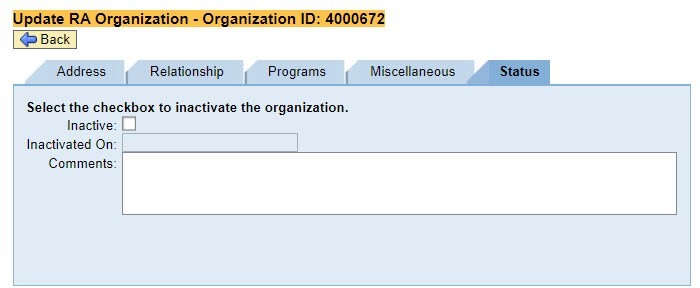
Coming Soon: Nutrition, Allergen, and Ingredient Information Available for USDA Foods In Schools
FNS is working on an initiative to make nutrition, allergen, and ingredient information for select USDA Foods direct delivery products available for States and school districts.
Through this initiative, FNS is leveraging an existing partnership with the Agricultural Research Service (ARS) Branded Foods Database to use the GS1 Global Data Synchronization Network TM (GS1 GDSN), a global database that makes it possible for vendors to share product information seamlessly, to provide vendor-specific nutrition information to States and school districts. This information will help to inform menu planning decisions and assist school districts in developing menus that are compliant with federal requirements for school meals.
USDA Foods vendors will be required to submit nutrition, allergen, and ingredient information in GS1 GDSN by December 31, 2021 for select direct delivery USDA Foods scheduled to be delivered beginning January 1, 2022. Fresh produce, most consumer-sized products, and bulk products for further processing are exempt from this requirement. Check out our list of products that will be required to be entered into GS1 GDSN.
States and school districts will be able to access this information on the FNS website in a non-editable Excel spreadsheet that will be updated monthly. States and school districts will now be able to compare nutrition, allergen, and ingredient information across vendors and will be able to access this information more efficiently. Each material that is required to be entered into GS1 GDSN will contain the following information:
- USDA material code number
- Brand name
- Nutrition facts and serving size
- Allergen information
- Ingredients
- Kosher certification
FNS is excited to implement this streamlined process that will allow States and school districts to access vendor-specific nutrition information. Providing vendor-specific information will help to increase confidence and satisfaction with USDA Foods. FNS will host a webinar in late summer to provide more details on this new initiative.
|
USDA Child Nutrition Program Waivers
On April 20, USDA released a series of Child Nutrition Program Waivers for School Year 2021-2022 (SY21-22). These waivers cover a variety of topics ranging from program options available for SY21-22, reimbursement rates, eligibility, nutrition standards, and program monitoring. We encourage stakeholders to review these documents and contact your State agency or FNS Regional Office with any questions. As a reminder, in January 2021 USDA also offered a USDA Foods entitlement waiver for SY21-22, which allows State agencies to use lunches served in SY18-19 to calculate USDA Foods entitlement, rather than SY20-21 meals. All States and territories opted into this waiver, ensuring that USDA Foods resources available nationwide will remain stable despite fluctuating meal counts. School districts with questions about their USDA Foods entitlement balance should contact their State Agency.

USDA DoD Fresh Updates
USDA continues to receive requests from States to add new schools or to increase their USDA Foods entitlement allocation for USDA DoD Fresh. The flexibility to add new sites or make changes to the allocation will continue throughout School Year 2021-2022. Since March 2020, 3,480 new sites have been added to the Fresh Fruit and Vegetable Order/Receipt System (FFAVORS). There has also been a steady increase in the amount of USDA Foods entitlement allocated to USDA DoD Fresh. In SY19, $326 million was spent, SY20 had an increase to $369 million, and over $500 million has been allocated for SY21. As we draw closer to the end of the school year, remember that unspent entitlement in FFAVORS is returned to the State and carried over to the following school year.
Schools should contact the produce vendor and DLA representative if there are issues with produce availability, produce quality and condition, or delivery issues. As a reminder, do not contact the vendor without including the DLA representative. Please contact USDADoDFresh@usda.gov if schools continue to experience issues after reporting the problem to the produce vendor and the DLA representative so we can work with DLA to resolve the issue.
This summer, 26 States have elected to participate in USDA DoD Fresh for the Summer Food Service Program (SFSP) pilot: Alaska, Arizona, Arkansas, Colorado, Connecticut, D.C., Florida, Georgia, Hawaii, Idaho, Illinois, Indiana, Iowa, Michigan, Montana, Nevada, New York, North Dakota, Ohio, Oklahoma, Oregon, Pennsylvania, Puerto Rico, South Carolina, Utah, and Vermont. This is the largest number of States participating in the pilot to date. These States have allocated all or part of their SFSP dollars toward the purchase of fresh fruit and vegetables through USDA DoD Fresh. We recommend that SFSP sponsors begin ordering produce as soon as SFSP starts in your state. This allows ample time for sponsors to spend their SFSP dollars by September 30. The use of USDA DoD Fresh in SFSP allows children to enjoy and benefit from a wide variety of nutritious in-season fresh produce. Remember SFSP dollars do not carry over and must be spent by September 30. Contact USDADoDFresh@usda.gov if you have questions about the pilot.
|

Where to Find USDA Foods in Schools Product Information
We know how important it is for school districts to have access to product information for each food included on school menus in order to meet the meal pattern requirements and make accommodations for student needs. The USDA has three main resources to help you find the information you need, including:
- USDA Foods Available List
- USDA Foods in Schools Product Information Sheets
- Product Specifications
The USDA Foods Available List can be found on the Food and Nutrition Service (FNS) website. This list is updated each year in December and includes every food item available for purchase for the following school year. It contains basic information such as the WBSCM material code and description, the food group it belongs to, form (i.e. canned, frozen, dried, fresh), pack size, and if the Product is a whole grain or has a required commercial Kosher certification.
The USDA Foods in Schools Product Information Sheets can also be found on the FNS website. Each product information sheet is organized by food group and can be identified by its USDA Foods description and WBSCM material code. These are useful for menu planning as they provide a more detailed product description, crediting and nutrition information, case yield, and culinary tips and recipes. While it is more detailed than the USDA Foods Available List, it is less detailed and technical than the product specification.
Product Specifications can be found on the Agricultural Marketing Service (AMS) website. Products can be searched by food type (i.e. fruits, vegetables, eggs, chicken, dairy, etc.) and form. Each product specification contains detailed information such as grade and size requirements, limits on specific nutrients, ingredients that are included or restricted, which commercial Kosher certifications a product may contain, or if a product is raw or cooked.
Still can’t find what you are looking for? Contact USDAFoods@usda.gov and we would be happy to assist you in getting the information you need.
|

USDA Foods Purchasing Frequency
As we enter a new school year purchasing period and try to normalize operations, we want to take an opportunity to remind States and school districts that USDA Foods are purchased throughout the year on different schedules depending on the product type and industry needs. Knowing when USDA Foods are purchased allows the state and recipient agencies to better plan orders for the school year and to know which orders can be added or changed throughout the year.
For some foods, such as seasonal fruits and vegetables, orders for the entire year are needed in the spring so the industry has firm order quantities and knows how much to plant and package for USDA Foods. For other foods, such as meat and cheese, USDA purchases product much closer to the time of delivery (e.g. 60 days in advance), so USDA offers order due dates throughout the year to allow States the flexibility to add, cancel, or change orders during the year with sufficient notice to USDA.
Please refer to the USDA Foods ordering schedule for product-specific information on USDA Foods procurement timelines.
|

FDPIR Direct Certification Report Now Available in IFMS
The newly released Integrated Food Management System, IFMS, which supports operations of the Food Distribution Program on Indian Reservations (FDPIR) now has a direct certification report available for users. This report will support the direct certification of FDPIR households with school-age children in the National School Lunch Program and School Breakfast Program. FDPIR Program Directors who use IFMS may share this report with local school agencies to streamline the process of registering eligible school-age children to receive meals during school hours. The direct certification report can be found under the reports section in the household certification folder of IFMS. School districts and state agencies may also find local FDPIR points of contacts here.
|
USDA plans to participate in the following upcoming conferences:
We hope to see you there!
Receipting Multiple Shipments in WBSCM
In Web-Based Supply Chain Management (WBSCM), when a vendor ships an order in multiple parts with more than one ASN, the order appears as multiple rows in the receipting screen. To help users select the correct row to enter receipt information, the ASN Number column has been added to the default view (eINV_VIEW). Users may also refer to the BOL# column to confirm that the correct row is selected.

Annual User Validation
USDA conducts an annual user validation and cleanup for WBSCM. All current users will receive instructions by email to ensure they retain access (if needed).
To continue their access to WBSCM, all users are encouraged to log in to their profile(s) periodically throughout the year. During the annual validation, User Administrators review user profiles for their respective organizations and lock user profiles after 9 months of inactivity and delete them after 12 months of inactivity.
Inactive Organizations
With the April release, WBSCM now allows Organization Administrators to inactivate sub-organizations, as needed. For example, an SDA can change the status of their RAs to inactive if they are no longer participating in programs. Inactive organizations cannot be selected for new transactions; however, they will continue to appear on existing transactions and in reports. For some administrative functions, users can switch between the lists of “active” and “inactive” users.
WBSCM will automatically record the date an organization was changed to inactive, and the Organization Administrators can enter comments to document the reason. If needed, inactive organizations can be reactivated.

WBSCM Resources
WBSCM is under continuous improvement through monthly development activities, and help resources are regularly updated to reflect the latest system changes and recommended processes. Available resource types include work instructions, job aids, simulations, course materials, and release notes.
To access the document library from WBSCM, navigate to Help → Training; then drill down through the categories, user groups, and functional areas or topics. These resources can also be accessed via on-screen help while performing most WBSCM transactions by clicking the Options button and selecting Help.
 For questions about WBSCM, please contact the WBSCM Service Desk or call (877) 927-2648.
System Reminders
- 5/27/2021 – WBSCM Maintenance Release 2021.R4.1.05
- 6/25/2021 – WBSCM Enhancement/Maintenance Release 2021.R4.2.06
- 7/10/2021 – FFAVORS 3.2 Release
- 7/29/2021 – WBSCM Maintenance Release 2021.R4.2.07
Planned dates for system activities are subject to change.
|